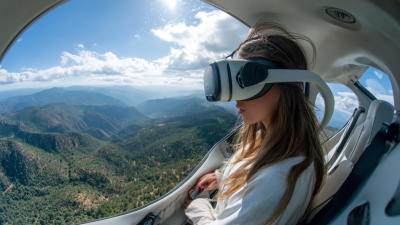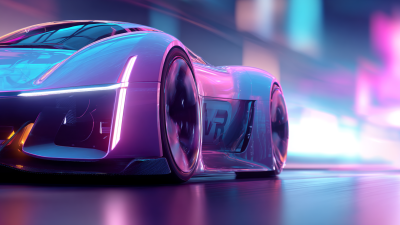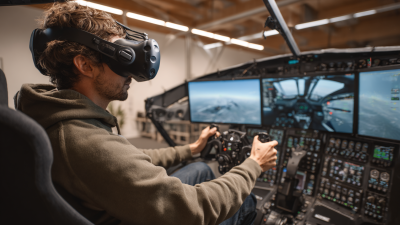Exploring the Future of Vr Standing Flight Technology in Gaming and Virtual Adventures
Table of Contents
- The Emergence of VR Standing Flight Technology in Gaming
- Key Innovations Driving the Future of VR Flight Experiences
- The Impact of Standing Flight on Immersion in Virtual Adventures
- Challenges and Limitations of VR Standing Flight Implementation
- User Engagement and Feedback: Shaping Future VR Flight Designs
- Comparative Analysis: Traditional Gaming vs. VR Standing Flight Experiences
- FAQS
- Conclusion
- Related Posts
In the rapidly evolving world of gaming and virtual adventures, the advent of VR Standing Flight technology is poised to redefine user experiences. As one of the pioneers in the VR simulator manufacturing industry, Guangzhou Longcheng Electronic Co., Ltd., VART VR, is at the forefront of this transformation.
 Located in Guangzhou, our company spans an impressive 8,000 square meters and is home to a dedicated team of over 60 professionals. We specialize in providing innovative one-stop solutions for VR and cinema projects, ensuring our clients remain competitive in this dynamic market.
The emergence of VR Standing Flight technology not only enhances immersion but also offers unprecedented opportunities for exploration within virtual environments, pushing the boundaries of gaming to new heights.
As we delve into the future of this groundbreaking technology, we are excited to share insights on how it will shape the landscape of digital entertainment and redefine the way players interact with immersive worlds.
Located in Guangzhou, our company spans an impressive 8,000 square meters and is home to a dedicated team of over 60 professionals. We specialize in providing innovative one-stop solutions for VR and cinema projects, ensuring our clients remain competitive in this dynamic market.
The emergence of VR Standing Flight technology not only enhances immersion but also offers unprecedented opportunities for exploration within virtual environments, pushing the boundaries of gaming to new heights.
As we delve into the future of this groundbreaking technology, we are excited to share insights on how it will shape the landscape of digital entertainment and redefine the way players interact with immersive worlds.
The Emergence of VR Standing Flight Technology in Gaming
The emergence of VR standing flight technology marks a significant evolution in the gaming and virtual adventure arenas. Unlike traditional gaming setups, this innovative approach immerses players in a captivating 360-degree environment where they can physically stand and navigate through expansive virtual worlds. By leveraging advanced motion tracking, players gain the ability to soar through skies, explore intricate landscapes, and engage in high-stakes missions, all while feeling an unprecedented sense of freedom and realism.
As the technology progresses, developers are keen to create experiences that not only utilize standing flight but also incorporate elements of social interaction and cooperative gameplay. Imagine a multiplayer adventure where friends can join forces, each taking to the skies in a seamless experience that blurs the line between reality and imagination. This potential for collaborative exploration enhances the gaming experience, fostering community and shared adventure in ways previously thought impossible. With VR standing flight technology at the forefront, the future of gaming promises to be more dynamic and engaging, shaping new narratives and experiences for players worldwide.
Key Innovations Driving the Future of VR Flight Experiences
The realm of virtual reality (VR) flight experiences is on the cusp of a transformative evolution, driven by key innovations that enhance immersion and interactivity. Advanced motion tracking technology allows players to experience the sensation of flight with unprecedented realism. By moving beyond traditional controllers, players can engage their entire bodies, replicating the natural movements of flying. This development not only enriches gameplay but also fosters a deeper emotional connection to the virtual environment.
At the forefront of this innovation is Guangzhou Longcheng Electronic Co., Ltd., through its VART VR brand. As one of China's pioneering VR simulator manufacturers, VART VR is dedicated to creating state-of-the-art VR experiences that transport users into breathtaking virtual worlds. With a robust infrastructure covering 8,000 square meters and a skilled team of over 60 professionals, VART VR is well-equipped to push the boundaries of VR flight technology. The company’s commitment to providing comprehensive VR projects positions it as a leader in shaping the future of gaming and virtual adventures, ensuring that users experience the thrill of flight like never before.
Innovations Driving VR Flight Experiences
The Impact of Standing Flight on Immersion in Virtual Adventures
The concept of standing flight in virtual reality (VR) gaming and adventures is revolutionizing how players experience immersion. By allowing users to remain upright while navigating virtual environments, this technology enhances the physicality of flight, making users feel as if they are truly soaring through the skies. This element of immersion is particularly potent in flight simulators, where the combination of visual stimuli and motion feedback effectively simulates the sensation of flying, creating a more engaging and realistic experience.
Recent developments in VR tourism further highlight the impact of standing flight technology. Attractions like Niagara Virtual offer visitors the chance to explore breathtaking locations from a new vantage point, where motion engineering and storytelling blend seamlessly with VR. The adrenaline rush of flying over iconic landscapes not only appeals to adventure seekers but also expands the possibilities of virtual exploration, inviting players to experience history, culture, and nature without leaving their homes. As the market for VR tourism and flight experiences continues to grow, standing flight technology will likely play a critical role in enhancing the consumer experience, transforming both gaming and travel into more dynamic and interactive realms.
Challenges and Limitations of VR Standing Flight Implementation
The implementation of VR standing flight technology in gaming and virtual adventures faces several challenges and limitations that developers must navigate. One significant barrier is the physical space required for true room-scale VR experiences. Players often need ample space to maneuver safely, which can limit accessibility for many users. Additionally, there are concerns regarding motion sickness, as prolonged use of standing flight simulations can lead to discomfort if not designed carefully.

Another challenge lies in creating immersive environments that remain consistently engaging. It takes skilled designers to not only develop realistic flight mechanics but also to ensure the surrounding environments are dynamic and responsive. As experimental titles push the boundaries of VR technology, the need for improved hardware that can deliver high-quality visuals and reduce latency becomes ever more critical.
Tips for developers include focusing on user experience by incorporating gradual acclimatization to flight controls, ensuring that new players can ease into the game without feeling overwhelmed. Moreover, offering customizable settings for movement speed and field of view can significantly enhance comfort levels, making flight simulators more inclusive. Emphasizing player feedback during the development phase can also lead to invaluable insights that address common issues users face while exploring VR flight.
User Engagement and Feedback: Shaping Future VR Flight Designs
As the gaming and virtual adventure landscapes evolve, user engagement and feedback become paramount in shaping the future of VR standing flight technology. Recent studies highlight that understanding pilot perspectives on flight simulation training devices can provide insights into user preferences and experiences. By tapping into the experiences of users, developers can create immersive environments that cater not only to entertainment but also to realistic training scenarios, enhancing both gaming and educational applications.

Tips: To encourage user engagement, designers should implement interactive features that allow players to provide immediate feedback on their experiences. This could include in-game surveys or integrated platforms for users to share their thoughts and suggestions. Additionally, incorporating age-related considerations into the design can help address the varying tolerances for VR experiences, thus improving overall comfort and satisfaction.
Moreover, the impact of sensorimotor mismatches on user experience in VR settings underscores the need for refined motion tracking and feedback systems. Developers must prioritize realistic sensory experiences to minimize discomfort and enhance immersion, especially for older adults who may experience greater susceptibility to VR sickness. By focusing on these key areas, the gaming industry can significantly improve its VR offerings and provide truly engaging adventures.
Comparative Analysis: Traditional Gaming vs. VR Standing Flight Experiences
The advent of VR standing flight technology has revolutionized gaming experiences, offering a new dimension that traditional gaming simply cannot match. In traditional gaming, players are often confined to a static environment, their actions limited to button inputs and controller manipulations. This creates a barrier to true immersion, as players engage with a screen rather than the virtual world. The interaction feels one-dimensional, relying heavily on avatars that do not translate the player's physical presence into the game.
In contrast, VR standing flight experiences engage players on a more profound level, allowing them to experience the thrill of soaring through virtual landscapes. With the ability to physically move around and interact with the environment, players can experience a sense of presence and agency that enhances gameplay. The immersive nature of VR technology fosters a deeper emotional connection to the game, as players feel physically involved in their adventures.
This paradigm shift not only redefines how we perceive gaming but also opens up new avenues for storytelling and exploration in virtual realms.
The comparative analysis between these two gaming styles clearly demonstrates that VR standing flight experiences provide a more enriched, engaging, and thrilling escapade for players.
FAQS
: VR standing flight technology is an innovative approach that allows players to physically stand and navigate through expansive virtual worlds, providing a captivating 360-degree immersive experience in gaming and virtual adventures.
It enhances gameplay by allowing players to engage their entire bodies in natural movements of flying, which fosters a deeper emotional connection to the virtual environment and enriches the overall experience.
Key innovations include advanced motion tracking technology that replicates the sensation of flight, along with improvements in hardware that enhance visual quality and reduce latency, making the experiences more immersive and interactive.
Developers face challenges such as the need for significant physical space for safe maneuvering, potential motion sickness issues, and the difficulty in creating consistently engaging and dynamic virtual environments.
Developers can improve user experience by incorporating gradual acclimatization to flight controls, offering customizable settings for movement speed and field of view, and actively seeking player feedback during the development phase.
Guangzhou Longcheng Electronic Co., Ltd., through its VART VR brand, is a key player, as it is dedicated to creating state-of-the-art VR experiences and has a skilled team focused on advancing VR flight technology.
The potential for social interaction includes multiplayer adventures where friends can collaboratively explore virtual skies, enhancing the gaming experience by fostering community and shared adventures.
To reduce motion sickness, developers can design simulations carefully, focusing on gradual acclimatization and offering options to customize movement settings to suit individual comfort levels.
Player feedback is crucial as it provides valuable insights into user experiences and common issues, guiding developers in creating more comfortable and engaging VR flight experiences.
The future of gaming promises to be more dynamic and engaging, as VR standing flight technology shapes new narratives and experiences for players, pushing the boundaries of reality and imagination.
Conclusion
The article "Exploring the Future of Vr Standing Flight Technology in Gaming and Virtual Adventures" delves into the transformative potential of VR Standing Flight in the gaming industry. It highlights how this innovative technology enhances immersion, allowing players to experience virtual environments in a more engaging manner. Key advancements driving the evolution of VR flight experiences are examined, along with the challenges that developers face in implementing these systems. Furthermore, the article emphasizes the importance of user feedback in shaping future designs and contrasts traditional gaming experiences with the dynamic nature of VR Standing Flight.
As a pioneer in VR simulator manufacturing, Guangzhou Longcheng Electronic Co., Ltd. VART VR is positioned to leverage these advancements. With a dedicated team and extensive facilities, the company is well-equipped to contribute to the development of next-generation VR experiences, catering to an evolving market that increasingly values immersive gaming and virtual adventures.
Related Posts
-

How to Elevate Your Business with Vr Flight Solutions
-

How to Choose the Best VR Flight Games for an Immersive Experience
-

The Definitive Guide to Understanding Vr Machine Price and Its Market Trends
-

Exploring the Evolution of Vr Car Technology and Its Impact on the Future
-

5 Tips for Mastering Your Experience with Vr Flying Simulator
-

How to Experience the Future of Entertainment with VR Theme Parks

